·Siemens Amberg factory: realized the mixed-line production of multi-variable IPCs, with a product pass rate as high as 99.9988%
FANUC: Achieving a highly automated and intelligent production process for robots and servomotors, up to 720 hours unattended
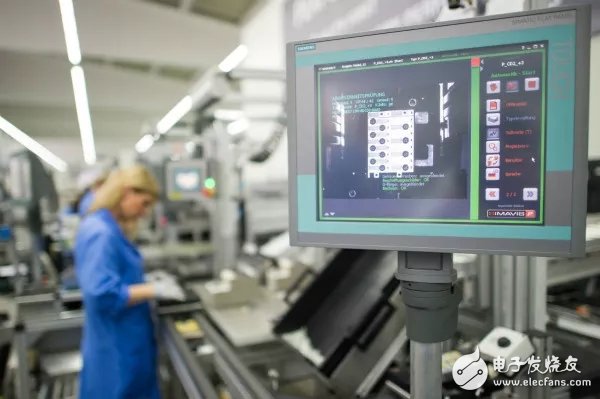
Schneider Electric: Full Automation of Electric Switch Manufacturing and Packaging Process
· Harley-Davidson, USA: Extensive use of intelligent manufacturing units consisting of machining centers and robots for mass customization
Mitsubishi Electric's Nagoya Production: The new robot assembly line incorporating man-machine integration has significantly increased the output per unit area of ​​production.
Heavy truck giant MAN: built a complete factory logistics system and established a material supermarket
In recent years, major economies around the world have been vigorously promoting the revival of manufacturing. Under the boom of Industry 4.0, Industrial Internet, Internet of Things, and cloud computing, many excellent manufacturing companies around the world have implemented smart factory construction practices.
According to Zhou Ji, dean of the Chinese Academy of Engineering, intelligent production is the main line of smart manufacturing, and smart factories are the main carriers of intelligent production. With the application of a new generation of artificial intelligence, in the next 20 years, Chinese companies will march to a new generation of smart factories that are self-learning, adaptive, and self-controlled. The combination of the new generation artificial intelligence technology and advanced manufacturing technology will revolutionize the production line, workshop and factory, and bring it to a historic new height, which will fundamentally improve the quality, efficiency and competitiveness of the manufacturing industry. For a considerable period of time in the future, the smart upgrade of production lines, workshops, and factories will become a major battleground for advancing smart manufacturing.
I. The connotation and construction focus of smart factory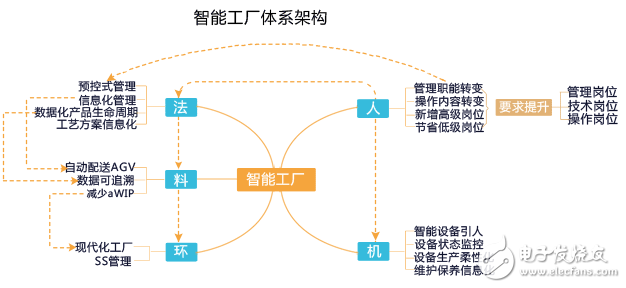
Smart factory is an important carrier for intelligent manufacturing. It mainly realizes the intelligentization of the production process by constructing an intelligent production system and networked distribution production facilities. The smart factory already has its own ability to collect, analyze, judge, and plan; inferring and predicting through the whole visual technology; using simulation and multimedia technology to augment the display design and manufacturing process with reality. Each component of the system can constitute its own optimal system structure, with the characteristics of coordination, reorganization and expansion. The system has self-learning and self-maintenance capabilities. Therefore, the smart factory realizes the coordination and cooperation between man and machine, and its essence is human-computer interaction.
The human-machine material method ring is the abbreviation for the five major factors affecting product quality in the total quality management theory. Person refers to the person who manufactures the product, machine, equipment used to manufacture the product, material refers to the raw material used to manufacture the product, method refers to the method used to manufacture the product, and ring refers to the environment in which the product is manufactured. Intelligent production is based on smart factories, connecting people, machines, methods, materials, and rings, and multi-dimensional integration.
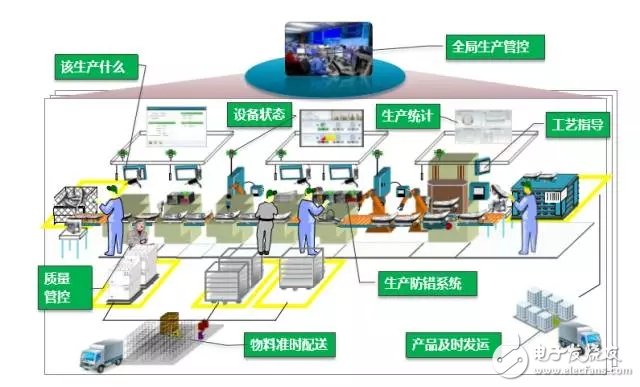
In the smart factory architecture, the five elements of quality management have also changed correspondingly, because in the future smart factories, humans, machines and resources can communicate with each other. Smart products "know" how they are manufactured and know their use. They will actively respond to manufacturing processes by answering questions such as “When did I make it?â€, “What parameters should I use for processing?â€, “Where should I be delivered?â€. The intelligent factory prototype based on CPS and industrial Internet, including the physical layer, information layer, big data layer, industrial cloud layer, and decision-making layer. Among them, the physical layer includes hardware devices at different levels in the factory, starting with the smallest embedded devices and basic components, and sensing devices, manufacturing equipment, manufacturing units, and production lines, and interconnecting and interoperating with each other. Based on this, a "integrated, controllable, and manageable" vertical integration environment was constructed. The information layer covers all aspects of the company's business operations, including various types of business management activities such as R&D and design, manufacturing and manufacturing, marketing services, logistics and distribution, as well as related businesses such as crowdsourcing, customization, e-commerce, and visual tracking. On this basis, a horizontally integrated environment for the internal value chain of the company is formed, and data and information are exchanged and exchanged.
Vertical integration and horizontal integration are based on CPS and industrial Internet. The integration of products, equipment, manufacturing units, production lines, workshops, factories, and other manufacturing systems, as well as their integration with businesses in different aspects of business, is through data applications and Industrial cloud services are realized, and the decision-making level is based on products, services, and equipment management to support the highest corporate decision-making. Together, these construct a smart factory complete value network system to provide users with end-to-end solutions.
Due to the obvious differences in the manufacturing process of products, discrete manufacturing and process manufacturing have different focuses on the construction of smart factories. For discrete manufacturing, products are often assembled from a number of components through a series of discrete processes. The process involves many changes and uncertainties, which, to some extent, increases the difficulty and support of discrete manufacturing organizations. Complexity. Companies often arrange the location of production equipment according to the main process flow in order to minimize the material transfer distance. Order-oriented discrete manufacturing companies have the characteristics of multi-category and small-batch production, and their process routes and equipment are more flexible. Therefore, discrete manufacturing companies pay more attention to the flexibility of production. The focus of smart factory construction is on smart manufacturing production lines.
Second, smart factory main construction modelDue to different production processes in different industries and different intelligence in different industries, smart factories have the following different construction models.
The first model is to digitize the production process to the smart factory. In the petrochemical, steel, metallurgy, building materials, textile, paper, medicine, food and other process manufacturing areas, the internal driving force for the development of smart manufacturing lies in the controllability of product quality, focusing on the development of digital production, and on the basis of quality control requirements from the end of product control. The entire process controls change.
The second mode is from the smart manufacturing of production units (equipment and products) to smart factories. In the discrete manufacturing fields of machinery, automobiles, aviation, shipbuilding, light industry, household appliances and electronic information, the core purpose of the development of smart manufacturing in enterprises is to expand the product value space, focusing on the automation of single equipment and the intelligentization of products, based on production efficiency. And increase product performance to achieve value growth.
The third mode is from personalization to interconnection factories. In household appliances, clothing, home appliances and other consumer products manufacturing areas that are closest to users, the focus of the company's development of smart manufacturing is to fully meet the diversified needs of consumers while achieving economies of scale production, focusing on large-scale personalized customization model innovation through the Internet platform.
Third, smart factory development key linksThe focus of smart production is to apply advanced technologies such as human-computer interaction and 3D printing to the entire industrial production process, monitor and collect data for the entire production process, facilitate data analysis, and create highly flexible, personalized, and networked technologies. Industry chain.
3D printing

3D printing is a disruptive and innovative technology. It was called by the American Science Foundation as the most important manufacturing technology innovation in the 20th century. The whole process of manufacturing can introduce 3D printing, which can save costs, accelerate progress, and reduce material waste. In the design process, with the help of 3D printing technology, designers can gain greater freedom and creative space. They can focus on product form creation and function innovation without having to consider the effect of shape complexity, because 3D printing can almost complete any shape. Item construction. In the production process, 3D printing can generate parts directly from the digital model, eliminating the need for specialized mold making and other processes, which saves costs and speeds time to market. In addition, traditional manufacturing processes typically generate waste during the casting, polishing, and assembly of parts, while the same parts can be formed in one shot using 3D printing, with virtually no waste. In distribution, 3D printing may challenge the existing logistics distribution network. In the future, parts and components will no longer need to be purchased and shipped from the original manufacturer. Instead, the 3D printed model files will be downloaded from the manufacturer's online database, which will then be quickly printed locally. This may result in the loss of parts storage and distribution systems throughout the world. The meaning of existence.
After nearly 40 years of development in 3D printing, leading companies have begun to achieve significant profitability, market recognition has rapidly increased, and industry revenue growth has accelerated. According to the typical product life cycle theory, technical products often show accelerated growth during the period from the introduction period to the growth period, and it is judged that the current 3D printing industry is entering an accelerated growth period.
Chart: Global 3D Printing Device Shipment Growth from 2008 to 2015
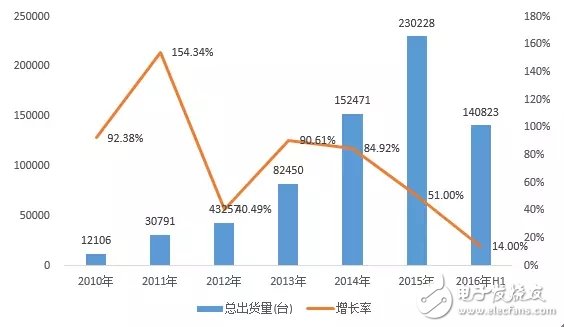
Source:Seri Research
The industrial chain of the entire 3D printing industry can be roughly divided into three parts: upstream basic accessory industry, 3D printing equipment manufacturing enterprise, 3D printing material production enterprise and supporting supporting enterprise, and the downstream is mainly the major application fields of 3D printing. The 3D printing industry in the usual sense refers mainly to 3D printing equipment, materials and service companies.
Chart: 3D Printing Industry Chain
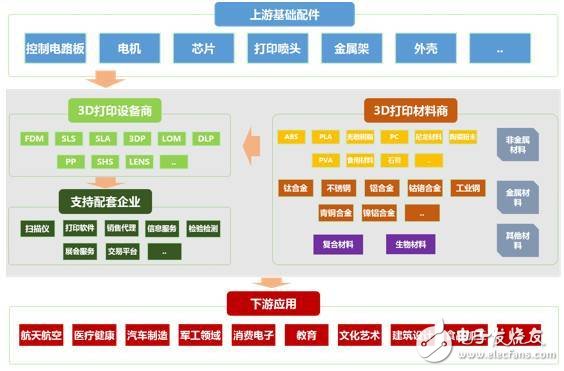
3D printing has formed a complete industrial chain. Each sector of the industry chain has gathered a group of leading companies. Globally, equipment companies represented by Stratasys and 3D Systems have taken a leading role in the industry chain, and these equipment companies are usually able to provide materials and print service businesses, for example, have a strong voice.
Chart: 2015 TOP5 Global Industrial/Professional 3D Printing Device Shipment
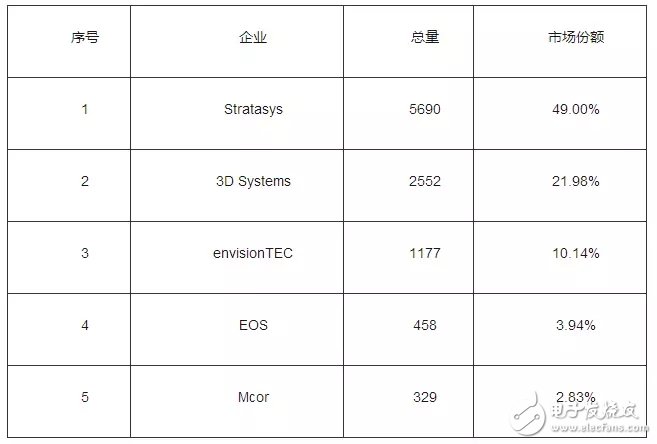
Source:Seri Research
Human-computer interactionIn the future, various types of interactions will be deeply integrated so that smart devices will naturally synchronize with human biological reactions and processes, including thinking processes, kinesthetics, and even a person’s cultural preferences. This field is full of novelties. The possibility.
The exchange of information between people and machines has progressed to a higher level as the pace of technological integration has accelerated, and new forms of human-computer interaction have been gradually applied to manufacturing. The specific performance in the intelligent interaction device flexibility and intelligent interactive devices industrial applications of these two aspects. In the production process, the intelligent manufacturing system can independently perform tasks such as analysis, judgment, and decision-making, highlighting the core position of people in the manufacturing system, and at the same time, in the cooperation of industrial robots, trackless avv and other smart devices, to better develop people's potential. Machine intelligence and human intelligence are truly integrated and work together to complement each other. The essence is man-machine integration.
sensorChina has basically formed a relatively complete industrial chain structure, with continuous improvements in materials, devices, systems, networks, etc., and has reached 6,000 kinds of independent products. China has established three major sensor production bases: Anhui Base and Shaanxi Base. Heilongjiang base. The government has proposed guidelines for accelerating the development of the domestic sensor industry. The future development of sensors will be improved towards the direction of intelligence.
Industrial softwareThe construction of a smart factory is inseparable from the widespread application of industrial software. Industrial software includes basic and application software. The system, middleware, and embedded technology belong to the basic technical scope. They are not closely related to specific industrial management processes and technological processes. The industrial software mentioned below mainly refers to application software, including operations. Management, production management, and R&D design software.
Under the background of “Made in China 2025â€, the transformation of industrial enterprises and the acceleration of integration will become the trend of the times, and the demand for industrial software and information services will continue to increase. China continues to maintain its position as the global growth force for the industrial software market.
Specifically, in 2016, China's industrial software industry, such as CAD, CAE, CAM, and CAPP, accounted for approximately 8.3% of product development, and information management such as ERP, CRM, and HRM, accounting for approximately 15.5. %; production control such as MES, PCS, PLC, etc. accounted for about 13.2%; the remaining 63% are embedded software development.
In terms of sub-regions, North China and East China are the areas with the largest number of industrial software applications, accounting for about half of the country. Looking specifically at the provinces and cities, Beijing, Shanghai, Guangdong, and Jiangsu are the regions with strong industrial software, accounting for approximately China's industrial software. More than half of the market size.
Widely use industrial software such as MES (Manufacturing Execution System), APS (Advanced Production Scheduling), PLM (Product Lifecycle Management), ERP (Enterprise Resource Planning), and Quality Management to achieve visualization and transparency at the production site. When building a new factory, simulations of equipment and production lines, plant logistics, and ergonomics can be performed through digital plant simulation software to ensure that the plant structure is reasonable. In the process of promoting digital transformation, we must ensure that the plant's data security and equipment and automation systems are safe. When detecting defective products by professional inspection equipment, it is necessary not only to automatically separate products with qualified products, but also to analyze the causes of quality problems through software such as SPC (Statistical Process Control).
Cloud Manufacturing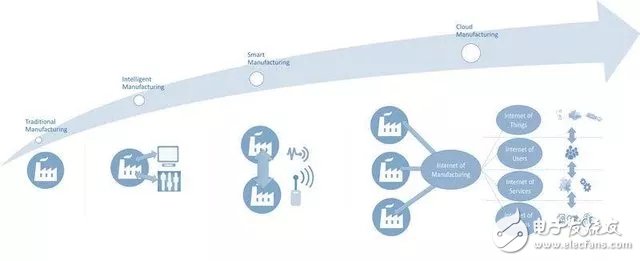
Cloud manufacturing and manufacturing companies integrate advanced information technology, manufacturing technology, and emerging Internet of Things technologies. The factory's production capacity, process, and other data are all focused on the cloud platform. Manufacturers can perform big data analysis and customer relationship management in the cloud and use the enterprise. Best performance.
The picture shows the concept of cloud manufacturing, and the process from traditional manufacturing to smart manufacturing to smart manufacturing to today's cloud manufacturing.
In China, we can see the cloud manufacturing service platform for aerospace complex products developed by China Aerospace Science and Industry Corporation. It has access to the various subsidiaries and bases of the Group and has a wealth of manufacturing resources and capabilities; China Railway Group is facing rail transit equipment. The group enterprise cloud manufacturing service platform has opened up the business of R&D, design, manufacture, repair and service of rail vehicles, engineering machinery, electromechanical equipment, electronic equipment and related components; cloud manufacturing platforms for SMEs have also emerged one after another. In the field of equipment manufacturing, luggage and shoes and other industries.
Cloud manufacturing provides a brand-new idea and model for manufacturing informatization. Cloud manufacturing, as a kind of initial concept, has a huge space for development in the future. However, the future development of cloud manufacturing still faces challenges of many key technologies. In addition to the integrated integration of technologies such as cloud computing, Internet of Things, Semantic Web, high-performance computing, and embedded systems, knowledge-based manufacturing resources cloud computing and manufacturing cloud management Engine, cloud manufacturing application collaboration, cloud manufacturing visualization and user interface technologies are all important technologies that need to be tackled in the future. Focus on the advanced manufacturing micro-channel ID (amdaily) for more intelligent manufacturing information.
to sum upThe construction of a smart factory is undoubtedly an important way for the transformation and upgrading of manufacturing companies. At the same time, it should focus on the company's medium and long-term development strategy and rationally plan the blueprint for the construction of smart factories based on the characteristics of its products, processes, equipment and orders. On the basis of advancing the standardization and standardization, we must start from the most urgent problems to be solved and pragmatically promote the construction of smart factories.
Iget Vape,Disposable Vape Iget Dual,Iget Dual Vape,Iget Xxl Disposable Vape Device
Nanning Nuoxin Technology Co., LTD , https://www.nx-vapes.com